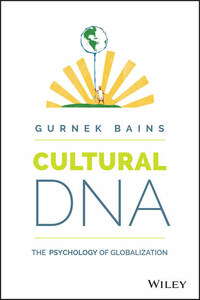Cover design: C. Wallace
Cover image: Balloon Earth © iStock.com/xochicalco
Copyright © 2015 by Gurnek Bains. All rights reserved
Published by John Wiley & Sons, Inc., Hoboken, New Jersey
Published simultaneously in Canada
No part of this publication may be reproduced, stored in a retrieval system, or transmitted in any form or by any means, electronic, mechanical, photocopying, recording, scanning, or otherwise, except as permitted under Section 107 or 108 of the 1976 United States Copyright Act, without either the prior written permission of the Publisher, or authorization through payment of the appropriate per-copy fee to the Copyright Clearance Center, 222 Rosewood Drive, Danvers, MA 01923, (978) 750-8400, fax (978) 646-8600, or on the web at www.copyright.com. Requests to the Publisher for permission should be addressed to the Permissions Department, John Wiley & Sons, Inc., 111 River Street, Hoboken, NJ 07030, (201) 748-6011, fax (201) 748-6008, or online at www.wiley.com/go/permissions.
Limit of Liability/Disclaimer of Warranty: While the publisher and author have used their best efforts in preparing this book, they make no representations or warranties with respect to the accuracy or completeness of the contents of this book and specifically disclaim any implied warranties of merchantability or fitness for a particular purpose. No warranty may be created or extended by sales representatives or written sales materials. The advice and strategies contained herein may not be suitable for your situation. You should consult with a professional where appropriate. Neither the publisher nor author shall be liable for damages arising herefrom.
For general information about our other products and services, please contact our Customer Care Department within the United States at (800) 762-2974, outside the United States at (317) 572-3993 or fax (317) 572-4002.
Wiley publishes in a variety of print and electronic formats and by print-on-demand. Some material included with standard print versions of this book may not be included in e-books or in print-on-demand. If this book refers to media such as a CD or DVD that is not included in the version you purchased, you may download this material at http://booksupport.wiley.com. For more information about Wiley products, visit www.wiley.com.
Library of Congress Cataloging-in-Publication Data:
Bains, Gurnek.
Cultural DNA: the psychology of globalization / Gurnek Bains.
pages cm
Includes index.
ISBN 978-1-118-92891-2 (hardback: alk. paper) 1. Cultural intelligence. 2. Leadership – Psychological aspects. 3. Career development. 4. Culture and globalization. I. Title.
HM621.B343 2015
303.48'2 – dc23
2014044837
From the start this project has been a family affair. My wife Kylie has provided much support in generating ideas. Her Australian cultural DNA has also ensured that the project actually happened, rather than staying a piece of “Indian reflective enquiry”. My two teenage children, Akal and Aman, have also helped. Akal's interest in economics and Aman's in psychology has meant that I have been able to give them significant sub-projects, in what we quickly discovered was a very ambitious undertaking.
I also want to thank everyone at YSC who has contributed and all of our global offices for their local insights. Our research department has also undertaken painstaking analysis of our database. I also want to thank Evgeniya Petrova, who did much of the literature research and Rosemary Burke-Kennedy who helped bring the manuscript to fruition.
Gurnek Bains
London 2015
We live in a world that is becoming flatter and flatter. Global business and trade, the ease of air travel and the unending flow of information and communication are all combining to create a kind of homogenized, cultural soup into which we are all being inexorably pulled. Whether you are in Beijing, Dubai, or Reykjavík, the ubiquity of global brands and the extent of cultural fusion can make everything around you look and feel comfortingly familiar, if somewhat blandly uniform. Backpackers know this and go to great lengths, admittedly sometimes in a self-defeating, cattle-like manner, to discover corners of the world that our global culture has not yet infiltrated or homogenized.
However, one theme emerges with surprising regularity when you talk to people who have moved to a different culture and lived there for some time – this surface similarity is something of an illusion only held by the transient tourist or business traveler. “You don't realize just how different this place really is once you have been here some time,” people who have deeper experience will often say. While things can appear familiar on the surface, over time a gradual realization sinks in that the deeper psychological and cultural instincts of different societies really are different in profound and nonsuperficial ways. You find that while it might have been easy to engage the culture initially, you eventually hit a permafrost layer through which an outsider cannot penetrate. Over time, you often become aware of just what you








